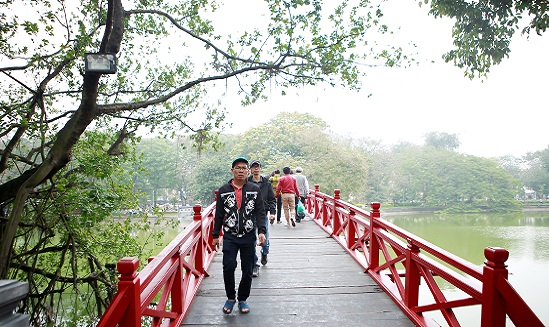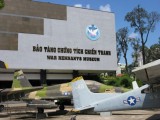Tour of Ngoc Son temple
Ngoc Son temple is perched on Jade islet in Hoan Kiem lake.

The Huc Bridge leads to Ngoc Son Temple
The temple which is a relic of culture and religious beliefs, is dedicated to Saint Tran Hung Dao and Guan Yu deity along with two generals classified as Saints, used to be the theater for naval drills of the Dai Viet navy.
History blended with myths create a historical cultural space around
The Ly dynasty in the eleventh and twelfth centuries erected the Bao Thien tower which was mirrored on the lake water.
In the subsequent centuries, the
Historical events and the monuments around Hoan Kiem lake enriched the treasure and proved the values of Ngoc Son temple - Hoan Kiem lake relic complex.
The temple is accessed through a bridge named "The Huc" (Light of Dawn) linking the Jade islet to the east bank of the Hoan Kiem lake.
The current architecture of Ngoc Son temple still retains the scale and style from the time the Confucianism scholar Nguyen Van Sieu conducted the renovation in the 19th century.
From the exterior, the tour around the relics begins from Outer Nghi Mon (Ceremonial Gate), Thap But (Pen Obelisk ), inner Nghi Mon, Dai Nghien (Ink Slab Tower); then it proceeds to the The Huc (Light of Dawn) bridge, Dac Nguyet (Moon Gazing) gate, Tran Ba (Tidal Wave Guarding) pavilion, Tien Te (Front-Worshipping) Chamber, Trung Duong (Central Hall), Hau Cung (Back Chambers), Ta Huu Vu (Left and Right Chambers), Kinh Thu (Holy Book) Chamber, Hau Cung (Tortoise Chamber).
The Outer Nghi Mon is made of brick with its two pillars holding a large fish scale roof. On the outer side of Nghi Mon, two big Chinese characters Phuc (Happiness) and Loc (Grace) are painted in red in the façade of the Gate, representing wishes of fertility and prosperity.
The yard after Nghi Mon is where the Pen Obelisk (Thap But) was erected on a base of four-meter high and 12m in diameter.
According to the epitaph, the base is called Doc Ton (Uniqueness) representing a mountain in commemoration of the fallen combatants during the Le-Trinh time in the 16th and 17th centuries.
The obelisk is divided into five levels and topped with the representation of a brush pen. On the northern side of the first three levels are three Chinese characters "Ta Thanh Thien" meaning "Writing on the clear blue sky”.
The Pen Obelisk is a symbol of literary spirit, standing on a “mountain” epitomizing the fighting spirit of Trinh lords and their soldiers. At the foot of Doc Ton “mountain”, there is also a shrine of the mountain god.
The Inner Nghi Mon next to the Pen Obelisk leads to Dai Nghien (
The Huc means "welcoming the morning sunlight ”. The name has inspired poets and painters alike to create memorable art works through the centuries. The Huc bridge leads to the fourth gate called Dac Nguyet gate.
Dac Nguyet means "Moon Gazing". The Dac Nguyet gate carries the philosophy of Taoism. This is a fairly solid brick structure with 2 storeys and 8 curved ridge lines on the roof. Inside the gate is the main architecture of the temple.
Tran Ba means ”Guarding the Tidal Waves”. The pavilion is located in front of the main temple to shield it from waves, wind or impure spirit from the lake.
A row of five chambers is next to Tran Ba pavilion. Ta vu, Huu vu (Left and Right Chambers) are adjacent to the main architecture of the temple. Ta Vu door looks out over the Dac Nguyet gate. Huu vu door faces the West, opposite to the Sword lake.
Kinh Thu (the Holy Book) chamber consists of 3 compartments with the floor tiled with Bat Trang brick.
Hau Cung or the Back Chamber (Tortoise Chamber) contains 3 compartments. This is the place where the preserved body of Ho Guom tortoise died on June 2, 1967 is displayed.
Tran Duy Hung, the late chairman of Hanoi People's Committee, personally instructed the protection and exhibition of the specimen at the Ngoc Son temple for the people to show their respect.
Hanoitimes
 Community tourism transforms livelihoods in remote areas
Community tourism transforms livelihoods in remote areas
 Agoda lists Da Lat among cheapest destinations for year-end holidays
Agoda lists Da Lat among cheapest destinations for year-end holidays
 TasteAtlas picks out two Vietnamese dishes among world’s 100 best rated crustacean dishes
TasteAtlas picks out two Vietnamese dishes among world’s 100 best rated crustacean dishes
 Vietravel expands business in Indian market
Vietravel expands business in Indian market
 2025 Nha Trang – Khanh Hoa Sea Festival to spotlight cultural heritage space
2025 Nha Trang – Khanh Hoa Sea Festival to spotlight cultural heritage space
Vietnam, a unique destination attracting Indian tourists: Indian newspaper
 Cao Bang eyes new opportunities for cross-border tourism development
Cao Bang eyes new opportunities for cross-border tourism development
 Kien Giang strives to attract tourists to finish the year on high note
Kien Giang strives to attract tourists to finish the year on high note
 Rivers provide major resources to boost Vietnam’s tourism
Rivers provide major resources to boost Vietnam’s tourism
 Dong Thap plants over 100 ha of flowers for Tet
Dong Thap plants over 100 ha of flowers for Tet



